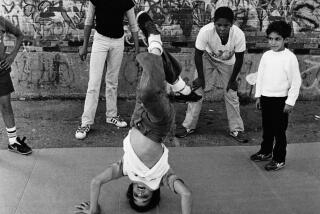Another First-Person Report on Swing Dancing
- Share via
I found quite entertaining Aimee Bender’s essay about dancing (“Redemption and Pathos,” July 19). While the author sees swing dancing as marking the end of the Depression and the success of World War II, the style most flourished in the mid-1930s, and American soldiers took the dance overseas with them. I believe that swing’s acrobatics and optimism were a reaction to the despair of the times. It was also a reflection of the large population of young people--and cheap entertainment.
We used to characterize swing, or “jump,” by a dance called the Lindy Hop, named after Charles A. Lindbergh’s 1927 transatlantic solo flight. The same dance appeared on the West Coast, but was called the Balboa.
A steamer transported dancers to Avalon on Catalina; they would literally dance onto the ship, dance during the voyage and still be dancing while they left the vessel. (The ballroom at the Casino at Avalon still has a great dance floor. The steamer, too, is still around, probably rotting in Mexico.)
By 1946, with the vanishing of most of the big bands, swing was already in a deep decline.
Samuel Zarcoff
Los Angeles
More to Read
Sign up for The Wild
We’ll help you find the best places to hike, bike and run, as well as the perfect silent spots for meditation and yoga.
You may occasionally receive promotional content from the Los Angeles Times.






